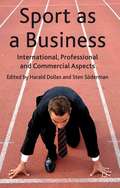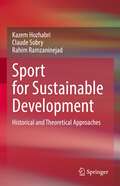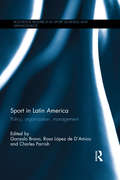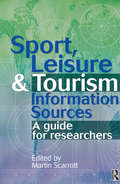- Table View
- List View
Sport and Migration: Borders, Boundaries and Crossings
by Joseph MaguireFrom Major League Baseball to English soccer’s Premier League, all successful contemporary professional sports leagues include a wide diversity of nationalities and ethnicities within their playing and coaching rosters. The international migration of sporting talent and labor, encouraged and facilitated by the social and economic undercurrents of globalization, mean that world sport is now an important case study for any student or researcher with an interest in international labor flows, economic migration, global demography or the interdependent world economy. In this dazzling collection of papers, leading international sport studies scholars chart the patterns, policies and personal experiences of labour migration within and around sport, and in doing so cast important new light both on the forces shaping modern sport and on the role that sport plays in shaping the world economy and global society. Presenting original case studies of sports from European and African soccer to Japanese baseball to rugby union in New Zealand, the book makes an important contribution to our understanding of a wide range of issues within contemporary social science, such as national identity politics, economic structure and organization, north-south relations, imperial legacies and gender relations. This book is invaluable reading for students and researchers working in sport studies, human geography, economics or international business.
Sport and Policy (Sport Management Series)
by Barrie Houlihan Matthew Nicholson Russell HoyeSport and Policy is the first book of its kind to critically analyse the regulatory role of the state and its impact on sport and the intersections of sport with other areas of government policy. Offering a unique and comprehensive examination of how sport is affected by a range of government policy, each chapter uses an international comparative approach in order to facilitate a broad understanding of sport and policy in a global context. This book is essential reading for any student or practitioner studying or working in policy today, and is: The first book to examine the intersection of sport with other (non-sport) policies from an international perspective including topics such as gambling, the media, social inclusion and economic development Far-reaching in scope encompassing government regulation and sport’s intersections with other government policies This challenging text provides an accessible critical analysis of the intersections of sport with government policy.
Sport and Quality of Life: Practices, Habits and Lifestyles (Social Indicators Research Series #84)
by Paolo Corvo Fabio Massimo Lo VerdeThis book brings together essays analyzing the impact of sport and physical activity on psychophysical well-being and quality of life, through multidisciplinary and multi-country studies. It discusses how the commercial dimension of sport entertainment and recreational dimension of sport practice have been increasingly brought together in discussions on individual health and well-being, and social integration and participation. It therefore considers the relationship between sports practice, enjoyment of sporting events, sport participation and quality of life. The chapters examine various aspects of the practice of sport for professional and recreational purposes from the perspective of age, life course research, physical education in schools, government investment in sport activities across various stages of life, the rise of sports tourism as a global industry and how social networks and web apps are changing the perception of fitness. This innovative book is of interest to scholars and students of sport science, leisure studies, and well-being research.
Sport and Social Capital
by ElsevierDespite the importance of sport as a social, economic and political institution, research into sport and social capital has not been extensive. Sport and Social Capital is the first book to examine this increasingly high profile area in detail. It explores the ways in which sport contributes to the creation, development, maintenance and, in some cases, diminution of social capital. Written by an internationally renowned author team who are leading figures in this area of study, this engaging and far-reaching text brings leading research from around the world into one comprehensively edited volume. Themes covered in the book include: education, gender, policy, community, youth sport, diversity and many more. It is essential reading for sport management, sport development and sport sociology students around the globe and offers fascinating and invaluable insight to interested stakeholders from industry, community and government.
Sport and Social Entrepreneurship in Sweden
by Tomas Peterson Katarina SchenkerThis edited collection explores the concept of social entrepreneurship in sport, examining how it has been used in Swedish society to date. It explores how this approach in sport could also be used to address wider socio-political issues, including economic, political, cultural and pedagogical in European society. Sport and Social Entrepreneurship in Sweden explores different social entrepreneurship projects which have created new forms of activity and reached groups of children and young people previously disengaged in sport. The authors also highlight the growing momentum of this kind of entrepreneurship in Sweden after a period of societal upheaval that has resulted in a blurring of social borders and the founding of new organisational forms. This book contributes to the formation of a new field of research, involving theoretical and empirical work on the characteristics and possibilities of social entrepreneurship in relation to sport.
Sport and Social Media in Business and Society (Routledge Focus on Sport, Culture and Society)
by Ryan King-White Gashaw AbezaThis concise, practical book examines the significance of social media for the sport industry, explaining key concepts and sharing tools and best practice for the use of social media in sport business communication. Accessibly written and avoiding jargon, the book considers the history, development, commercial impact, social effects, and the legal and ethical concerns of social media in the context of sport. Covering all levels of sport, from professional to grassroots, the book includes international cases and examples throughout, presenting key findings from current research. It also explains the role of social media agencies and the fundamentals of managing a sport organization’s social media platforms and outputs. This book is essential reading for all sport business professionals and for any sport business, management, or marketing student looking for a primer on this important and growing subject.
Sport and Sustainable Development: An Introduction
by Stavros TriantafyllidisSport has the potential to be a powerful platform for positive change. This is the first textbook to introduce the fundamentals of sport and sustainable development, examining how sport can be made more sustainable in terms of its social and environmental impact, and how sport can achieve more comprehensive social and ecological objectives. Introducing key theory, and looking at how sustainability has been embedded in real-world organizations, projects, and developments, the book draws on a range of multidisciplinary perspectives including sport business and management, development studies, environmental studies, sociology, psychology, and political science. Every chapter includes international viewpoints from the voices of professionals who have been successful in achieving sustainable development goals (SDGs) in and through their work. As pressure grows on sport, business, and wider society to put sustainability and social and environmental responsibility at the center of their operations, the themes and topics examined in this book become ever more important. This is essential reading for any course on sport and sustainable development, and important background reading for any course in sport management, sport development, event studies, environment and society, business and the environment, or social responsibility.
Sport and Tourism
by James Higham Tom HinchSport and Tourism: Globalization, Mobility and Identity marks a new era in sport tourism texts. Written by global experts whose previous collaborations have been integral to the development of the field, the book applies key social science concepts and issues relevant to the academic study of sport and tourism. This is a ground-breaking text, which: Critically explores the wider manifestations of sport-related tourism and mobilityAddresses key themes such as globalization, mobility and identity Explores the unique interrelationship that exists in a sport tourism context between activity, people and place Includes case studies written by a range of leading scholars from around the world Set to be the an essential text for any student or academic in the field, this book cements and advances previous studies by building upon existing literature, while extending the field by exploring avenues of study that are yet to be comprehensively addressed. The latest collaboration by internationally renowned authors applies new theoretical perspectives for the advancement of sport tourism.
Sport and the British World 1900�1930
by Erik NielsenThis book provides a lively study of the role that Australians and New Zealanders played in defining the British sporting concept of amateurism. In doing so, they contributed to understandings of wider British identity across the sporting world.
Sport and the Media: Managing the Nexus (Sport Management Series)
by Matthew Nicholson Anthony Kerr Merryn SherwoodSuccessful media relations and a sound communication strategy are essential for all sport organizations. Any successful manager working in sport must have a clear understanding of how the media works, as well as the practical skills to manage the communication process. Now in a fully revised and updated second edition, Sport and the Media: Managing the Nexus is still the only textbook to combine in-depth analysis of the rapidly developing sport media industry with a clear and straightforward guide to practical sport media management skills. The book explains the commercial relationships that exist between key media and sport organisations and how to apply a range of tools and strategies to promote the achievements of sport organisations. This updated edition includes a wider range of international examples and cases, as well as four completely new chapters covering new and social media, managing the media at major sports events, the work of the sports journalist, and the role of the sport media manager. The book's online resources have also been updated, with new lecture slides and teaching notes providing a complete package for instructors. Sport and the Media is an essential textbook for any degree level course on sport and the media, sport media management or sport communication, and invaluable reading for any sport media or sport management practitioner looking to improve their professional skills.
Sport and the Media: Managing the Nexus (Sport Management Series)
by Matthew Nicholson Anthony Kerr Merryn Sherwood Ashleigh-Jane ThompsonNow in a fully revised and updated third edition, Sport and the Media: Managing the Nexus combines in-depth analysis of the rapidly developing sport media industry with a clear and straightforward guide to practical sport media management skills. The book explains how the media works, as well as the practical skills necessary to manage the communication process. It explores the commercial relationships that exist between media and sport organisations, as well as the shift towards in-house media production, and explains how to apply a range of tools and strategies to promote the message, brand and achievements of sport organisations. This updated edition includes three completely new chapters introducing the fundamentals of storytelling, the growing significance of social issues, and the diversity of job roles and careers in sport media. It also features expanded coverage of digital technologies and social media, as well as profiles of industry professionals. This is an essential textbook for any degree level course on sport and the media, sport media management or sport communication, and invaluable reading for any sport media or sport management practitioner looking to improve their professional skills. Additional resources include case diagnostics, tutorial plans, test bank, additional readings, and links to useful websites and videos.
Sport and the Neoliberal University: Profit, Politics, and Pedagogy
by Susan Searls Giroux Joshua I. Newman Michael D. Giardina Ryan King-White Henry Giroux Neal C. Ternes Jaime DeLuca Callie Batts Maddox Matthew G. Hawzen Lauren C. Anderson Ellen J. Staurowsky Richard M. Southall Crystal Southall Oliver Rick Adam Beissel Jacob J. Bustad Ronald L. MowerCollege students are now regarded as consumers, not students, and nowhere is the growth and exploitation of the university more obvious than in the realm of college sports, where the evidence is in the stadiums built with corporate money, and the crowded sporting events sponsored by large conglomerates. The contributors to Sport and the Neoliberal University examine how intercollegiate athletics became a contested terrain of public/private interests. They look at college sports from economic, social, legal, and cultural perspectives to cut through popular mythologies regarding intercollegiate athletics and to advocate for increased clarity about what is going on at a variety of campuses with regard to athletics. Focusing on current issues, including the NCAA, Title IX, recruitment of high school athletes, and the Penn State scandal, among others, Sport and the Neoliberal University shows the different ways institutions, individuals, and corporations are interacting with university athletics in ways that are profoundly shaped by neoliberal ideologies.
Sport and the Pandemic: Perspectives on Covid-19's Impact on the Sport Industry (Routledge Research in Sport Business and Management)
by Paul M. Pedersen, Brody J. Ruihley and Bo LiThis book takes a close look at how the sport industry has been impacted by the global Coronavirus pandemic, as entire seasons have been cut short, events have been cancelled, athletes have been infected, and sport studies programs have moved online. Crucially, the book also asks how the industry might move forward. With contributions from sport studies researchers across the world, the book offers commentaries, cases, and informed analysis across a wide range of topics and practical areas within sport business and management, from crisis communication and marketing to event management and finance. While Covid-19 will inevitably cast a long shadow over sport for years to come, and although the situation is fast-evolving and the future is uncertain, this book offers some important early perspectives and reflections that will inform debate and influence policy and practice. A timely addition to the body of knowledge regarding the pandemic, this is an important resource for researchers, students, practitioners, the media, policy-makers, and anybody who cares about the future of sport.
Sport as a Business
by Harald Dolles Sten SodermanSport has a number of distinctive characteristics whichimpact onthe extent of its globalization. This book seeks to gain a deeper understanding of the unique development in sports, its governance, its logic of co-creation of value and the advancement of the industry towards internationalisation, professionalization and commercialization
Sport for Sustainable Development: Historical and Theoretical Approaches
by Claude Sobry Kazem Hozhabri Rahim RamzaninejadThis book looks at the potential of sport to contribute to wide-ranging development outcomes, which have been recognized across international policy declarations, most significantly in the 2030 UN Agenda for Sustainable Development. It provides a theoretical approach to sport and development. It begins by addressing the basic concepts of sport development and sustainability and then discusses the potential contribution of sport to five prioritized SDGs (SDGs 3, 4, 5, 8 and 16) and the environment as one of the sustainable development pillars that may contribute to SDGs 6, 7, 11, 12, 13, 14 and 15. This academic resource provides a macro view to students and researchers of sports sciences to know more about the fundamental concepts of sustainable development goals, and to enhance their knowledge about sport as a conduit that can help achieve wider development outcomes rather than being an end in itself. This book is of interest to students and researchers of sports studies, from sociology to management, and researchers and policy makers interested in sport and sustainable development.
Sport in Contemporary India: Society, Culture and Governance (Routledge Research in Sport, Culture and Society)
by Lovely Dasgupta Surajit C. MukhopadhyayThis book examines the development and significance of sport in contemporary India, one of the fastest growing sports markets worldwide.Featuring multi-disciplinary work from leading Indian scholars in sociology, economics, politics, law and business, the book demonstrates how sports help us to better understand the sociocultural and economic forces that have shaped modern India and are shaping its global, post-colonial future. The book explores many of the key themes in contemporary sports studies, including women in sports and advertisements, doping, commercialisation, nationalism, sports in education and the growth of fantasy sports, and shows how law and society intersect in sports governance. Examining the historical roots of sport in India and, of course, featuring work on India’s greatest game – cricket – the book shines new light on the development of this South Asian superpower and on how sport both reflects and shapes wider society.This book will be fascinating reading for anybody with an interest in Indian or Asian history, culture or society, or in sport business, sport development, sports law, or the sociology and culture of sport.
Sport in Korea: History, development, management (Routledge Research in Sport, Culture and Society)
by Dae Hee Kwak Yong Jae Ko Inkyu Kang Mark RosentraubKorea has become a powerful force in global sport, with South Korea finishing fifth in the medals table at London 2012 and hosting the Winter Olympics in 2018. This book brings together scholars from disciplines including sport history, sociology, journalism, economics, sport development, and sport management to explore the significance of sport in contemporary Korea. Presenting a variety of international perspectives, it plots the dynamic evolution of sport in Korea and envisions the possibilities for its future. Each chapter focuses on a key topic of current relevance, such as sport in the context of shifting relations between North and South Korea, or the role of sport in the expression of Korean nationalism. Arguing that individuals, institutions, businesses, and governments have actively leveraged or exploited sport to influence developments in various social, economic, cultural, and political arenas, this book sheds new light on the importance of sport as a catalyst for change in Korea. This is indispensable reading for any student or scholar with an interest in sport, history, and culture in Korea.
Sport in Latin America: Policy, Organization, Management (Routledge Research in Sport Business and Management)
by Gonzalo Bravo Charles Parrish Rosa LópezThe forthcoming Olympics in Rio in 2016, and the FIFA World Cup in Brazil in 2014, highlight the profound importance of sport in Latin America. This book is the first to offer a broad survey of the way that sport is managed, governed and organized across the Latin American region, drawing on cutting-edge contemporary scholarship in management, policy, sociology and history. The book explores key themes in Latin American sport, including the role of public institutions; the relationship between sport policy and political regimes; the structure and significance of national governing bodies and professional leagues; the impact of sporting mega-events (including the Olympics and World Cup), and the management and governance of football, the dominant sport in the region. Including contributions from Latin American scholars and practitioners, the book draws on important Spanish and Portuguese sources that are unknown to most English-speaking researchers, and therefore provides an unprecedented and authoritative insight into sport policy and management in the region. Including cases from sport in Brazil, Argentina, Chile, Colombia, Cuba, the Dominican Republic, Costa Rica and Peru and examples from Venezuela, Bolivia and Ecuador, this book is essential reading for all scholars, practitioners and policy-makers with an interest in Latin American sport, comparative sport policy, sport management, or Latin American history, culture and society.
Sport in the Iberian Peninsula: Management, Economics and Policy (Routledge Research in Sport Business and Management)
by Gonzalo A. Bravo Jerónimo García-Fernández Moisés Grimaldi-PuyanaThis is the first book in English to offer an overview of the development of the sport industry in Spain and Portugal, examining the social, economic, cultural, and political impact sport has had in this region and on world sport more broadly. Drawing on sources in Spanish and Portuguese, the book presents important new perspectives and empirical material not previously available to English-speaking audiences. With a strong focus on management, development, economics, governance and law, set in a broader historical and socio-cultural context, the book explains the unique characteristics of the sport industry in the Iberian Peninsula. It takes a deep dive into Spanish and Portuguese football - in many ways the centre of gravity of Iberian sport – and into sport tourism, a hugely significant component of the broader economy of the region. The book also considers important emerging themes in Iberian sport, from the development of women’s sport to the global profile of Cristiano Ronaldo and Rafael Nadal, and considers the wider influence of Iberian sport across the wider Hispanic diaspora. This is fascinating and illuminating reading for anybody with an interest in sport business and management, global sporting cultures, international business, or Hispanic or Latin American studies.
Sport und öffentliche Finanzen: Die sportbezogenen Einnahmen und Ausgaben öffentlicher Haushalte in Deutschland (essentials)
by Tim Pawlowski Christoph BreuerDem Sport werden zahlreiche Gemeinwohlfunktionen zugeschrieben. Aus diesem Grund wird er mit öffentlichen Mitteln gefördert. In welchem Umfang der Sport in Deutschland auf diese Weise gefördert wird und insbesondere welche Mittel aus dem Sport wieder an die öffentlichen Haushalte zurückfließen, war bislang unklar. Auf Basis einer Vielzahl von Datenquellen werden in diesem Beitrag die sportbezogenen direkten Einnahmen und Ausgaben der öffentlichen Haushalte systematisch abgeschätzt. So ergibt sich - je nach Abgrenzung des Sportsektors - ein differenziertes Bild der finanzpolitischen Bedeutung des Sports in Deutschland.
Sport, Advertising and Global Promotional Culture: Identities, Commodities, Spaces and Spectacles (Routledge Research in Sport, Culture and Society)
by David L. Andrews Steven J. JacksonThis book explores the intersection of contemporary sport, advertising, promotional culture and wider society.Arguing that advertising and promotional culture remain key driving forces in relation to social structures and systems that contribute to enduring patterns of economic and other forms of inequality, this book examines how sport and related areas of social life continue to be transformed by these forces. Presenting in‑depth international case studies covering topics such as Nike’s sign economies, the sports‑gambling‑media complex, sportswashing/greenwashing, radical politics in sport advertising, sport and corporate nationalism, and girls’ empowerment and transgender exclusion in sports, this book sheds critical new light on some of the most important themes in the study of global consumer culture in the emerging era of surveillance capitalism. Overall, this book examines sport advertising through the lens of the circuit of cultural commodification – including production, representation, consumption and regulation – in order to provide insights into the formation, complexities and contradictions of social identities, commodities and brands.This is fascinating reading for anybody with an interest in the sociology, culture and politics of sport, or cultural studies, media studies, and the wider politics and social significance of late‑stage capitalism.
Sport, Development and Environmental Sustainability (Routledge Studies in Sport Development)
by Simon C. Darnell Rob MillingtonThis is the first book to consider the intersections of sport, international development and environmental sustainability. It explores the tensions between sport’s potential contribution to the environment and its rather poor record to date. Bringing together a diverse group of scholars who approach the topic from various disciplinary and theoretical perspectives, the book provides both critical and optimistic perspectives on the place of sport in sustainable development. Chapters examine and question how and whether sport contributes to sustainable development on an international scale. Attention is also paid to the place and role of Indigenous knowledge in sustainable Sport for Development, particularly as an alternative to modernization and/or in support of reconciliation with Indigenous peoples. Sport, Development and Environmental Sustainability is important reading for academic researchers, students and policy-makers in the fields of kinesiology, sport studies, sport sociology, leisure studies, sport management, sport media, physical cultural studies, environmental studies and sustainability and international development studies.
Sport, Events, Tourism and Regeneration (Contemporary Geographies of Leisure, Tourism and Mobility)
by John Harris Nicholas WiseInvestments in sport, events and tourism in cities and wider regions are part of nascent regeneration strategies linked to transitioning economic bases and place images. While it is important to consider physical regeneration, there is a range of subsequent benefits and opportunities brought about through regeneration that considers social impacts, communities and how investments and developments influence how people interact in transformed spaces. This book brings together a collection focusing on the diverse range of approaches and perspectives of regeneration. Twelve chapters outline and bring together critical perspectives of regeneration from scholars in different parts of the world. This collection critically assesses some of the key factors impacting upon regeneration initiatives in relation to sport, events and tourism. By doing so, this book assesses if new opportunities have arisen from developments, increasing the demands and needs of locals and tourists, or if transformations result in exclusion - thus challenging who regeneration is for. This book will be valuable reading for students and academics interested in tourism studies, events planning, sport and leisure studies or development studies, as well as the wider social sciences.
Sport, Leadership, and Social Inclusion (Routledge Focus on Sport, Culture and Society)
by Hans Erik Næss Mari SvendsenThis book considers how sport organizations can create inclusive practices to strengthen social progress, focusing on the importance of leadership in fostering positive change.Drawing on original research, and adopting a meso-level, multi-disciplinary approach that includes perspectives from sport management, the sociology of sport and organizational psychology, the book considers the evidence for sport as a vector of social progress. Featuring qualitative interviews with non-profit sport leaders from organizations across Europe, the book looks at the conditions under which social inclusion through sport is possible and examines the challenges and opportunities related to three areas of inclusivity and exclusivity: access, participation, and empowerment.Offering a new perspective on how leadership can help unlock the potential of sport as an inclusive force in society, this book is an important read for anybody with an interest in sport development, sport management, social inclusion, or the relationship between sport and wider society.
Sport, Leisure and Tourism Information Sources
by Martin ScarrottSport, Leisure and Tourism is a practical guide to finding information, encouraging readers to make active use of libraries in their research. This book provides readers with an understanding of the major information search tools which are available. It is a starting point in the search for information which offers advice and indicates some of the major sources which are available. Sport, Leisure and Tourism Information Sources is aimed primarily at final year undergraduate and postgraduate students who are preparing a dissertation in the area of sport and leisure studies who need access to information sources. It is also ideal for academics for teaching purposes and practitioners in the sport and leisure industry needing to undertake research.
























